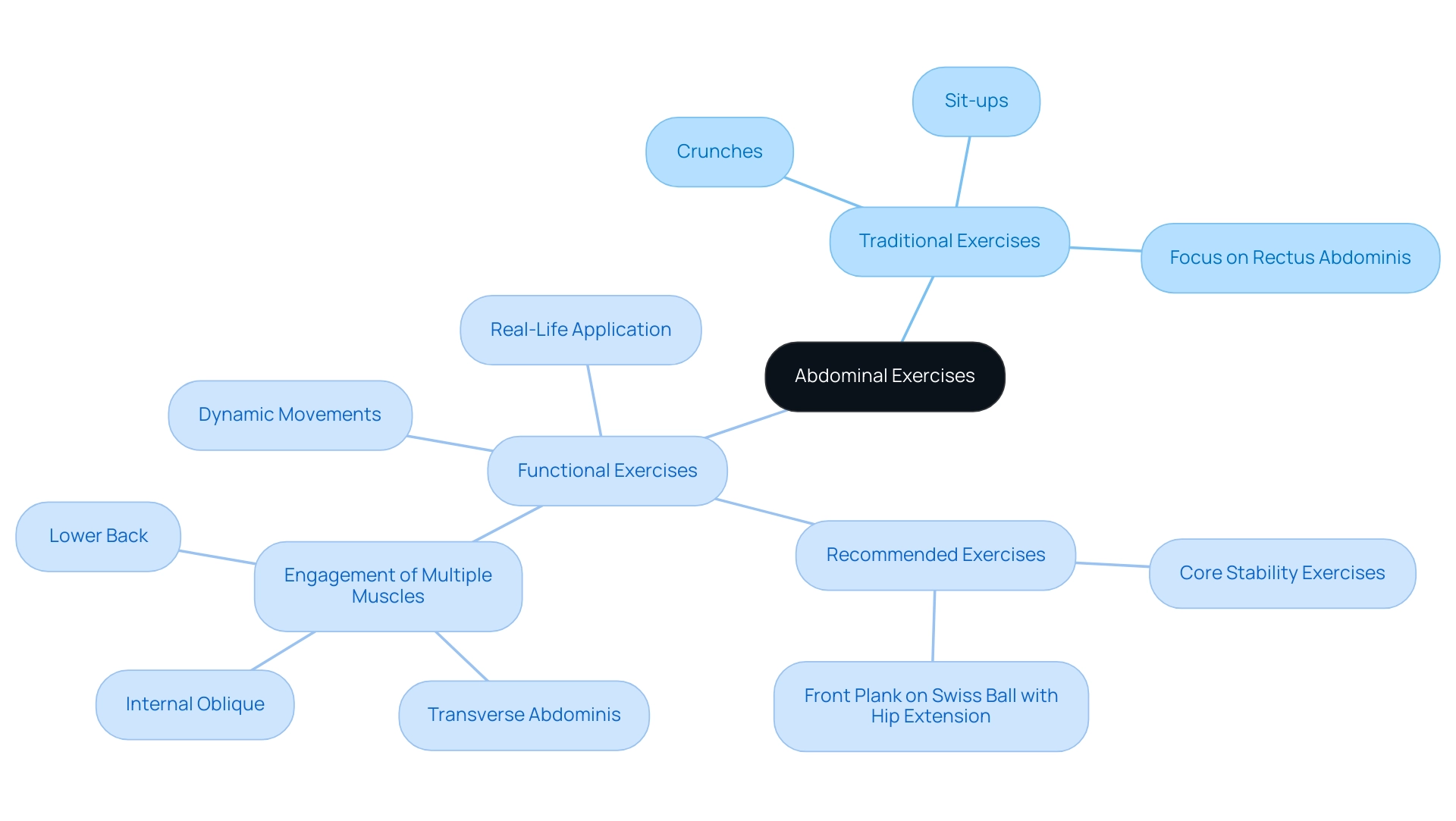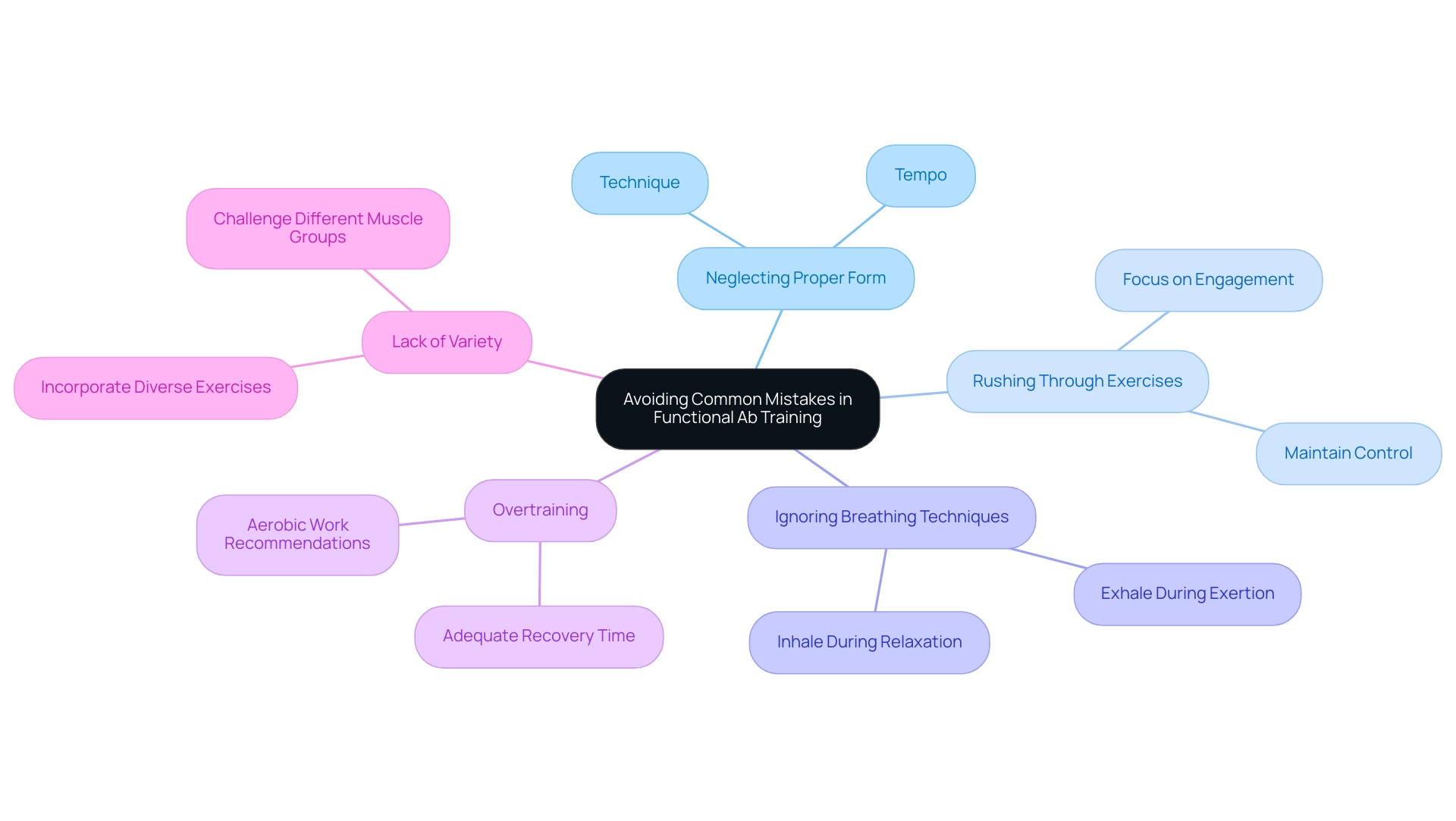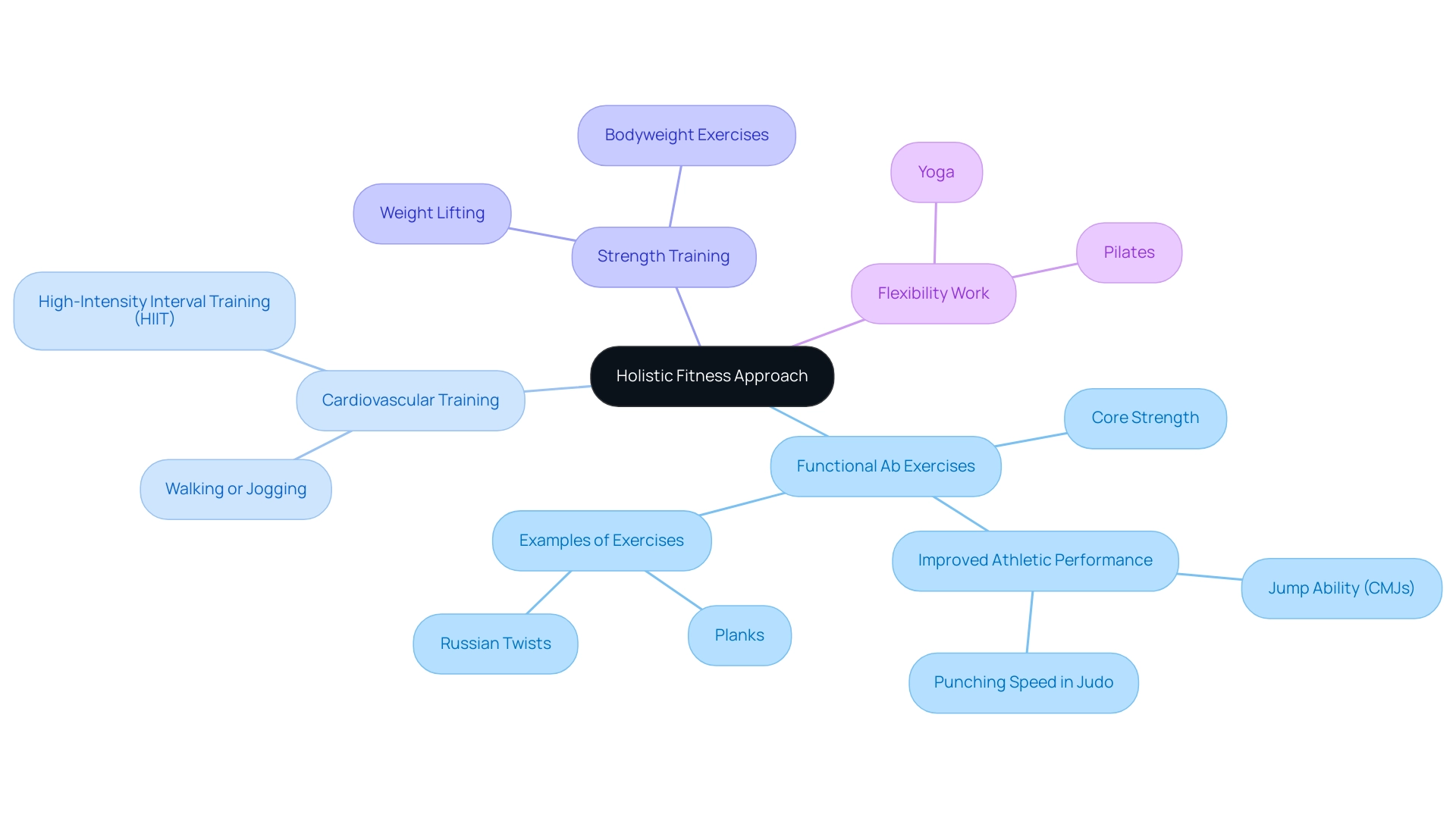Overview
The best functional ab exercises are essential for enhancing core strength and stability, as they engage multiple muscle groups and mimic real-life movements. The article supports this by highlighting that exercises like planks and medicine ball twists not only improve overall physical performance but also reduce injury risks and enhance everyday functional capabilities.
Introduction
In today’s health-conscious world, the significance of core strength cannot be overstated. As individuals seek to enhance their physical performance and overall well-being, functional ab exercises have emerged as a game-changer. Unlike traditional approaches that focus solely on aesthetics, these innovative workouts engage multiple muscle groups, mimicking real-life movements and fostering improved stability and coordination. With a wealth of research backing their effectiveness, functional ab exercises not only bolster athletic performance but also play a crucial role in everyday activities, reducing the risk of injury and promoting better posture.
This article delves into the unique benefits of functional ab workouts, contrasts them with traditional methods, and offers practical tips for integrating these exercises into a holistic fitness routine.
Defining Functional Ab Exercises: What Sets Them Apart?
The best functional ab exercises are crucial in improving central strength and stability, as they are specifically designed to imitate actions experienced in everyday life. Unlike traditional ab workouts, which tend to isolate abdominal muscles, these functional activities engage multiple muscle groups, thereby promoting improved coordination and balance. For example, activities like:
- Planks
- Medicine ball twists
- Stability ball rollouts
not only strengthen the center but also play a crucial role in improving posture and lowering the risk of injury during everyday tasks.
Recent research highlights the effectiveness of core stability exercises, as evidenced by a meta-analysis examining core workouts' impact on horizontal jump performance, which found a substantial effect size of 0.84 in favor of core exercises. This indicates that incorporating the best functional ab exercises into training regimens can enhance overall physical performance. Significantly, a study by McGill & Marshall (2012) involving participants aged 25.60 ± 3.40 years reinforces the importance of consistent EMG measurement methods, aligning with the idea that high-quality research is crucial to validate the advantages of these activities.
Additionally, there is grade B evidence supporting the use of fundamental stability activities (CSE) to reduce symptoms and enhance patient function, which reinforces the case for their effectiveness. The Effective Public Health Practice Project (EPHPP) scale was utilized to evaluate the methodological quality of studies on essential training, emphasizing the significance of strong research in demonstrating the advantages of practical ab routines. Consequently, the best functional ab exercises not only help to strengthen the midsection but also promote a more resilient and capable body, ready to confront daily challenges.

The Benefits of Functional Ab Exercises: Enhancing Everyday Performance
The best functional ab exercises provide a wealth of benefits that go far beyond mere aesthetics. These activities are vital for improving central stability, a key element for sustaining correct posture and balance in a range of tasks. Research supports the effectiveness of central stabilization routines, with findings from 14 studies conducted during competition and rest periods demonstrating that they significantly reduce pain and enhance muscle activation.
For instance, Ioannis Tsartsapakis notes,
The results indicate that the hollowing maneuver led to a greater increase in the thickness of the Tra, IO, and LM across all seven activities tested, compared to the bracing maneuver.
Significantly, activities such as the bird dog and side plank are considered the best functional ab exercises for boosting muscle thickness in the midsection, leading to improved stability.
Enhanced central strength, achieved through the best functional ab exercises, not only boosts performance in sports and physical activities but also reduces the risk of injuries. It promotes better movement patterns, making everyday activities—such as lifting, bending, and twisting—safer and more efficient. As a result, individuals involved in these activities can also experience heightened energy levels and improved overall productivity in their daily lives.
The implications of these findings are profound, particularly for those engaged in recreational activities and rehabilitation, as emphasized in the case study titled "Implications for Core Stability Training," where core stability plays a vital role in recovery from core-related injuries.

Functional vs. Traditional Ab Exercises: Understanding the Differences
The difference between practical and traditional abdominal routines is fundamentally based on their training methodologies. Traditional workouts, such as crunches and sit-ups, predominantly focus on the rectus abdominis, often isolating this muscle group. On the other hand, the best functional ab exercises are designed to engage the entire midsection, including the obliques, transverse abdominis, and lower back, through dynamic movements that reflect real-life activities.
This comprehensive development method not only strengthens the foundation but also greatly improves overall athletic performance and practical fitness, making it more applicable for everyday life and physical activities. Bobby Best effectively encapsulates this change in emphasis, stating,
So, the key takeaways from this article: developing the center for function rather than appearance is significantly different.
Recent research has shown that activities such as the front plank on a Swiss ball with hip extension produce greater muscle activation than static planks, further confirming the effectiveness of practical conditioning approaches.
Significantly, the average relative thickness of all three main muscles (Transverse Abdominis, Internal Oblique, and Lower Multifidus) was greater when employing the hollowing maneuver compared to the bracing maneuver (p < 0.001), emphasizing the physiological advantages of practical training. It's important to note that muscle thickness changes observed through ultrasound cannot be directly compared to studies using electromyography or MRI, which adds a layer of complexity to the interpretation of these findings. Furthermore, a case study titled 'Impact of Activity Type on Muscle Activation' demonstrated that various types of activities, including free-weight and stability routines, influenced muscle activation differently, with stability routines recommended for Internal Oblique activation due to their effectiveness in engaging these muscles.
By involving various muscle groups, the best functional ab exercises in practical abdominal routines offer a thorough workout that conventional methods frequently lack, leading to enhanced stability and practical skills.

Top Functional Ab Exercises to Incorporate into Your Routine
Incorporating the best functional ab exercises into your regimen can greatly improve strength and stamina, particularly for men over 50. Here are some top activities to consider:
- Plank Variations: Engaging the entire midsection, plank variations such as side planks and plank shoulder taps improve stability and endurance. Recent evaluations underscore their efficiency, with professional suggestions stressing the importance of these activities in developing a strong foundation. Notably, McGill et al. (2009) examined competitive strongman athletes during different events, highlighting the significance of central stability in practical strength.
- Russian Twists: Targeting the obliques, Russian twists enhance rotational strength, which is crucial for various sports and daily activities. Instructors often suggest this activity for its capacity to mimic real-life movements and enhance practical fitness.
- Medicine Ball Slams: This dynamic exercise combines strength and cardiovascular fitness, effectively working the core while promoting explosive power. It serves as an excellent way to boost overall functional performance. Research indicates that engaging in strength training, as shown in Fisher et al.'s study where the Romanian deadlift group increased their 1RMs by 16.1% after 10 weeks, can lead to significant enhancements in abdominal strength.
- Bicycle Crunches: A highly effective dynamic activity, bicycle crunches target multiple abdominal muscles while mimicking movements encountered in daily life, thereby reinforcing stability.
- Stability Ball Rollouts: This challenging movement enhances central stability and strength, contributing to improved balance and coordination. Significantly, studies have demonstrated that static positions, like those seen in modified curl-ups, produce greater EMG activity compared to dynamic movements, highlighting the importance of performance.
Integrating the best functional ab exercises into your weekly routine can promote a strong and effective core, vital for sustaining an active lifestyle.

Avoiding Common Mistakes: Tips for Effective Functional Ab Training
To enhance the effectiveness of the best functional ab exercises, it is crucial to avoid several common pitfalls:
- Neglecting Proper Form: Prioritizing proper form is essential for preventing injuries and ensuring optimal muscle engagement. As a key principle in training, understanding technique and tempo within the confines of anatomical capabilities maximizes performance.
- Rushing Through Exercises: Maintaining control is vital; taking your time with each movement allows for better engagement and maximizes the benefits of the workout.
- Ignoring Breathing Techniques: Breathing is integral to core engagement. Exhaling during exertion and inhaling during relaxation enhances performance and stability.
- Overtraining: To prevent fatigue and foster muscle growth, ensure adequate recovery time between workouts. This is crucial for maintaining strength and endurance, particularly for men over 50. It is recommended to perform aerobic work 3-5 days a week to support overall fitness.
- Lack of Variety: Incorporating a diverse range of exercises not only keeps workouts engaging but also challenges different muscle groups effectively. As emphasized in the case study named 'Special Nature of Practical Exercise,' the aim of practical exercise is to enhance overall movement efficiency and improve all aspects of fitness.
By concentrating on these elements, including the best functional ab exercises, individuals can greatly enhance their performance results while lowering the risk of injury. Moreover, taking into account evidence-based methods, it is essential to mention that while multi-component practical exercise shows promise, the strength of evidence for such approaches remains low, particularly in certain populations.

Integrating Functional Ab Exercises into a Holistic Fitness Approach
Incorporating the best functional ab exercises into a comprehensive fitness approach is essential for promoting overall health and wellness, especially for individuals over 50. These activities should not exist in isolation; they must be complemented by:
- Cardiovascular training
- Strength training
- Flexibility work
to create a balanced regimen. Tailored corporate wellness programs, supported by our customized app, can provide the individualized support necessary to ensure that each team member engages in appropriate exercises.
For instance, combining fundamental workouts with yoga or Pilates can significantly enhance flexibility and body awareness. Meanwhile, incorporating high-intensity interval training (HIIT) elevates cardiovascular fitness, making workouts more dynamic and effective. Notably, studies underscore the measurable benefits of the best functional ab exercises on athletic performance, such as those assessing jump ability via Countermovement Jumps (CMJs) and their impact on judo athletes' punching speed, illustrating the performance advantages of a strong core.
Emphasizing nutrition and recovery is also vital to sustaining an active lifestyle and maximizing performance. This comprehensive approach reflects a growing recognition of the interconnectedness of various fitness modalities, supported by case studies in health and wellness coaching that utilize behavioral science principles to promote lifestyle changes. By addressing the specific challenges faced by firms in maintaining employee well-being, and by embracing this strategy, HR Benefits Managers can markedly improve their team's physical health, productivity, and overall quality of life, ultimately demonstrating that investing in your team’s health is an investment in your firm’s success.

Conclusion
Functional ab exercises represent a pivotal shift in the approach to core training, emphasizing the importance of functional strength over aesthetics. By engaging multiple muscle groups and mimicking real-life movements, these exercises enhance core stability, balance, and coordination, which are essential for both athletic performance and everyday activities. The research supporting the effectiveness of functional ab workouts is compelling, demonstrating their ability to reduce injury risk, improve posture, and contribute to overall physical performance.
Integrating functional ab exercises into a comprehensive fitness routine can lead to significant enhancements in daily functionality and athletic prowess. Exercises such as:
- Planks
- Russian twists
- Medicine ball slams
not only strengthen the core but also promote better movement patterns, making everyday tasks safer and more efficient. Moreover, understanding the common pitfalls in training and focusing on proper form, breathing techniques, and variety can further optimize results.
Ultimately, embracing functional ab workouts as part of a holistic fitness strategy—complemented by cardiovascular training, strength work, and flexibility exercises—ensures a well-rounded approach to health and wellness. This comprehensive methodology not only fosters physical strength and resilience but also enhances overall quality of life, underscoring the value of investing in core strength for long-term health benefits. By prioritizing functional training, individuals can equip themselves to tackle daily challenges with confidence and efficiency.




